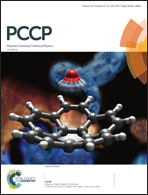Investigating the effect of ionic strength on the suppression of dendrite formation during metal electrodeposition†
Abstract
The effect of ionic strength on the electrodeposition of silver has been investigated in acetonitrile (MeCN) containing TBAPF6 or in the ionic liquid [EMIm][OTf]. The use of an ionic liquid allows a greater ionic strength to be investigated as the solubility limits of supporting electrolytes in organic solvents can be overcome using neat ionic liquid. The SEM and XRD data show that polycrystalline silver is deposited in a fcc structure and that dendrite formation is retarded at high ionic strength. Electrochemical measurements undertaken in electrolytes of low ionic strength indicate that the deposition and growth of a few nuclei is preferred and leads to dendrite formation. However, at higher ionic strength, the deposition and growth of significantly more nuclei is observed and therefore dendrite growth rates and tip currents are lower leading to the deposition of spherical particulates. Crucially, the data shows that if the ionic strength of the electrolyte is controlled there are no differences between ionic liquids and molecular solvents for the electrodeposition of silver.



 Please wait while we load your content...
Please wait while we load your content...